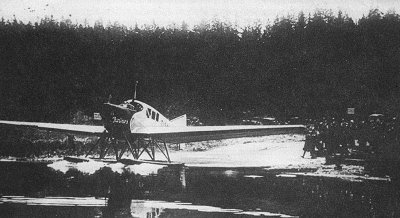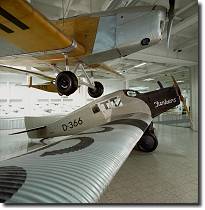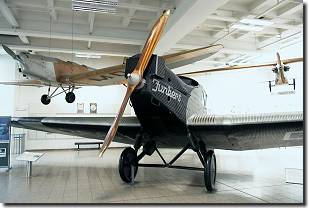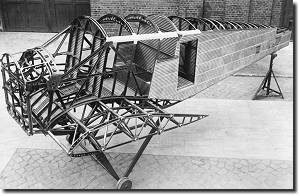|
Junkers F 13

The "Junkers F 13" is the first
modern commercial aircraft. Outstanding design features make it an key
example of an entire generation of commercial aircraft:
The cabin for the passengers is closed, accommodates four persons, and
is equipped with comfortable upholstered seats, heating and
illumination. Following the precedent of spacious automobiles used for
long-distance journeys in those days, Junkers also referred to his F
13 as an air limousine.


The wing, with its relatively deep
profile, is a low-wing cantilever monoplane and not based on a biplane
design with struts and bracing wires, which was common at that time.
The drag was reduced considerably by the abandonment of exterior
wires, struts and attachment fittings. The low-positioned wing
provides increased safety to the passengers in case of emergency
landings. When ditching (carrying out emergency landings on water) the
aeroplane remained capable of floating for some time.

The framework of the F 13 consists of light
alloy profiles and tubes riveted to each other. At the end, this
framework is covered with preformed corrugated sheet metal parts. The
wing and fuselage framework are built according to the Junkers patent
"Monoplane with self-supporting wings" of 1918.
The aeroplane is made entirely of a
light metal alloy (duraluminium) and covered with corrugated sheet
metal, instead of employing a wood and steel tube construction with
fabric covering, which was common in those days. The corrugated sheet
metal admits a high inherent stiffness and thus requires only a few
interior supporting elements. The light alloy construction makes the F
13 rugged, resistant to climatic conditions, easy to repair, and
therefore long lasting.
The open cockpit offers space for
two pilots and is equipped with a dual control mechanism for the first
time. Thus, the pilots can share the work and take turns at the
control on longer flights.
The first flight of the F 13 took
place in June 1919. Soon afterwards record flights such as a
high-altitude flight with 8 occupants at an altitude of 6,750 m and a
non-stop, long-distance flight covering 1,900 km in 12 hours and 10
minutes drew attention to the capability of the new aircraft.

Aeroplanes built as a seaplane version are
used for traffic between seaports and for longer flights over water.
Here, an F 13 has landed in a bay near Rio de Janeiro (in the
background you can see the Sugar Loaf Mountain).
The F 13 contributed considerably to
the development of air traffic in the twenties. Many less developed
and sparsely populated countries that did not have a developed air
traffic system began to rely on the aeroplane for passenger, freight
and postal traffic in the twenties and thirties. A total of about 330
F 13s were built in 60 different versions and sold to 30 countries
from 1919 until 1932. They were still in use as passenger and freight
planes until well into the thirties.
Experience gained in the operation
of Junkers airlines was evaluated systematically and employed in
design improvements. An entire series of large aeroplanes with
corrugated covers evolved from the F 13. The final result was the
extraordinarily successful three-engined commercial aeroplane Junkers
Ju 52/3 m built in 1932.
The F 13 was a further development
of the Junkers W 33 freight plane, whose exterior is similar to its
ancestors. Flying a W 33 that had been specially modified for the
record breaking attempt, Hermann Köhl, E.G. von Hünefeld and J.
Fitzmaurice made the first successful Atlantic crossing from East to
West in 1928.
|